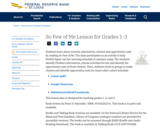
Students will practice talking about their daily routines and hygiene. Students will also practice asking and answering questions.
- Subject:
- Arts and Humanities
- Languages
- Material Type:
- Assessment
- Date Added:
- 10/29/2019

Students will practice talking about their daily routines and hygiene. Students will also practice asking and answering questions.

Students will talk about the days of the week and discuss their weekly schedules.

Food vector created by gstudioimagen - www.freepik.comIn this activity, students will practice talking about their daily routines and hygiene. Students will practice asking and answering questions.

In this activity, students will practice talking about their daily routines and hygiene. Students will practice asking and answering questions.

Students will practice the days of the week and describe their daily/weekly schedule.

Students will practice answering open-ended questions using vocabulary from the past chapters.

Students will each get a card describing a made up weekly schedule. They will try to work together to find a day and time that they can meet up and practice speaking and writing Chinese.

In this activity students will practice discussing and describing events in their daily lives. Students will build a daily schedule from an assortment of random events, and then describe their schedule to a group or partner. Students will practice using correct and accurate time phrases in Chinese.

In this resource, you will learn what routines are and how to establish them in your daily schedule, how to decide how much time you spend on a section of your day to increase instructional time, and the importance of including brain breaks throughout the day.

tudents learn about scarcity, alternatives, choices and opportunity costs by reading So Few of Me. The class participates in an activity to help Perdita figure out her morning schedule at summer camp. The students identify Perdita's alternatives, choose activities for her and identify the opportunity costs of those choices. Then, students work in groups to make choices and identify opportunity costs for Juan's after-school schedule.

In this activity students will be practice telling time in Chinese, as well as create schedules to describe their daily lives. Students will also practice listening comprehension by accurately responding to prompts given by the instructor.

In this activity students will be practice telling time in Chinese, as well as create schedules to describe their daily lives. Students will also practice listening comprehension by accurately responding to prompts given by the instructor.

In this activity students will be practice telling time in Chinese, as well as create schedules to describe their school lives, and describe school subjects. Students will also practice interviewing with each other by sharing their school life and make comments on culture understanding about school life in America and China.

In this activity students will be practice telling time in Chinese, as well as create schedules to describe their daily lives. Students will also practice listening comprehension by accurately responding to prompts given by the instructor. Students also will build cultural understanding on school life between China and America.

This tiered task involves interpretive reading of an authentic school schedule and presentational writing to compare the schedule to students’ own schedules. This task is tiered by complexity of product (how students show what they know).Suggested Extension or Follow-Up ActivitiesIf students worked with different schedules, they could compare the results.Speaking activity – Students ask each other questions about the schedules.Students design their ideal schedule.Students give a “tour” of their schedules (Walk around school or use a map to describe schedule. En la primera hora, tengo la clase de español con la Señora Sherrow…)Image source: "Child" by picjumbo_com on Pixabay.com